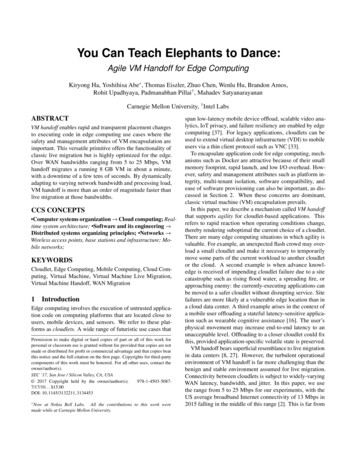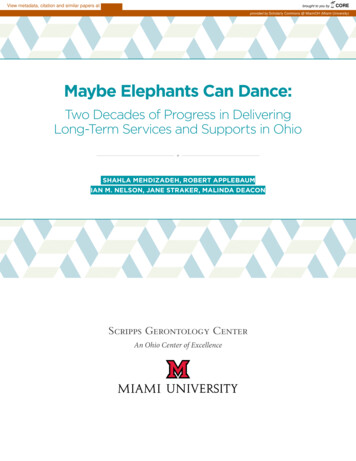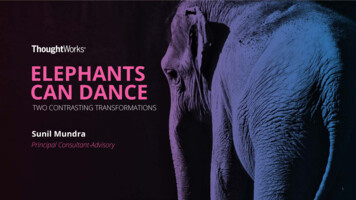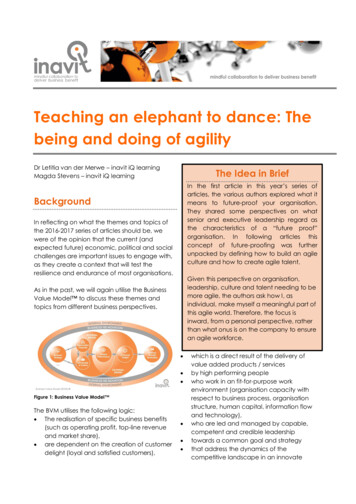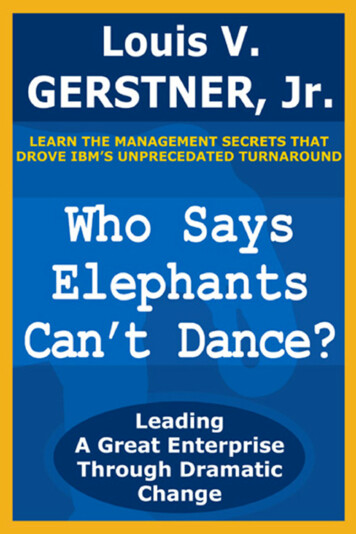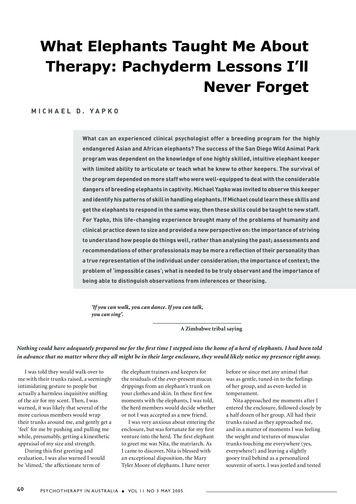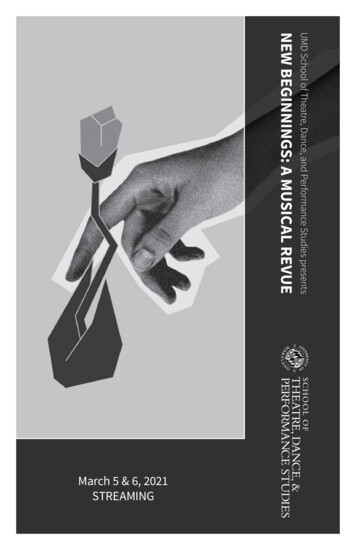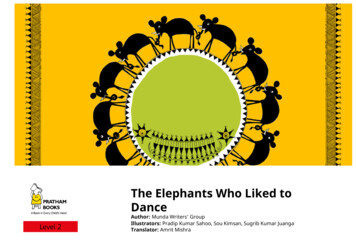
Transcription
The Elephants Who Liked toDanceAuthor: Munda Writers' GroupIllustrators: Pradip Kumar Sahoo, Sou Kimsan, Sugrib Kumar JuangaTranslator: Amrit Mishra
2/20
Bapi was a little boy who loved to play the dhol.Dhum Dhum Dhuma Dhum Bapi would beat the dhol with his eyesclosed and his hands moving fast. This would make you want todance!3/20
4/20
One day Bapi had to go to the village on the other side of thehill. He was very happy because he had been asked to play thedhol there.To reach that village he had to cross a dense forest.5/20
6/20
As he walked along, he ran into A HERD OF ELEPHANTS! Bapi wasso scared!You would be scared too if you saw how big the elephants were.7/20
8/20
He started beating his dhol loudly. He thought the elephants wouldget scared of the noise.But what do you think happened?9/20
10/20
The elephants were delighted to hear the dhol! They starteddancing happily.They forgot about Bapi as they simply loved to dance. Seeing hischance to escape, Bapi ran home. He told the villagers abouteverything that had happened.11/20
12/20
The next day, the boys and girls from the village went to pickmohua flowers. They were shocked to see that the elephants werestill dancing!They ran back to the village and told everyone about the dancingelephants.13/20
14/20
The villagers brought many different kinds of drums and went tothe forest beating them loudly.The dancing elephants were still dancing to the beat of Bapi’s dhol.When they heard so many different kinds of drums their feet lostthe wonderful rhythm of Bapi’s beat. The confused elephantsturned and ran away into the forest!15/20
16/20
Would you like to play the dhol like Bapi?17/20
The ConceptIndia’s diverse linguistic landscape has a rich seam of stories for children.Unfortunately, many tribal languages do nothave literature for children in book form or books for reading pleasure. Asincreasing numbers of tribal children go to school, it is now more necessarythan ever to create a body of children’s literature in their languages. Literaturethat reflects their own world and opens up the world beyond because booksare magical, powerful things that inform, amuse, educate and entertain in themost interactive way. Books make every child an independent and life-longseeker of knowledge in her own unique way. For education to be trulymeaningful to every child, she must get good books to read in her ownlanguage.The ProjectPratham Books and IgnusERG, with the support of Bernard van LeerFoundation have created the first ten books for children’s reading pleasure inMunda, Kui, Saura and Juanga languages from Odisha. The stories were writtenand illustrated by authors and illustrators belonging to these tribes in a seriesof workshops. This series of books is called Adikahani. It is a significant firststep towards giving a voice to cultures that do not find adequaterepresentation in mainstream discourses.18/20
The PartnersIgnusERG is a guild of resource persons working to support teachers andenhancing the quality of education, particularly in government schools. Theyfocus their efforts on bringing equity in education and addressing the needs ofmarginalized children.Bernard van Leer Foundation is an international grant-making foundationbased in The Hague. Its mission is to improve opportunities for young childrengrowing up in socially and economically difficult circumstances. It has aparticular interest in supporting mother-tongue based education.This story was written by the Munda Writers’ Group consisting of BudhanathaMunda, Prafull Surin, Prafulla Tapno, Rabindra Kumar Singh and Santosh KumarSingh. With a background in ECCE, they all interact with children regularly. It hasbeen illustrated by Sugrib Kumar Juanga using the Saura wall mural style as a base.The Munda language has more than 5 lakh speakers and is spoken in Sundargarh,Mayurbhanj and Keonjhar districts of Odisha. It is a group of languages spread overa geographical area beyond state boundaries and has been a repository offascinating myths that have attracted linguists and litterateurs. The spellings of thelanguage in Odia script are not definitive as many new sounds are being renderedin print for the first time.19/20
20/20
This book was made possible by Pratham Books' StoryWeaver platform. Content under CreativeCommons licenses can be downloaded, translated and can even be used to create new stories ‐provided you give appropriate credit, and indicate if changes were made. To know more aboutthis, and the full terms of use and attribution, please visit the following link.Story Attribution:This story: The Elephants Who Liked to Dance is translated by Amrit Mishra . The for this translation lies with Pratham Books, 2014. Some rightsreserved. Released under CC BY 4.0 license. Based on Original story: 'ହାତୀମାନ ନାଚ/ହାତୀକଆଃ ସୁସୁ ', by Munda Writers' Group . Pratham Books , 2014. Somerights reserved. Released under CC BY 4.0 license.Other Credits:'The Elephants Who Liked to Dance' has been published on StoryWeaver by Pratham Books as a part of Adikahani series of ten books. The development ofthis book has been supported by Bernard van Leer Foundation along with our Content Partner IgnusERG. www.prathambooks.orgImages Attributions:Cover page: Elephants in a circle, by Sou Kimsan Pratham Books, 2014. Some rights reserved. Released under CC BY 4.0 license. Page 2: Man with a drum,by Sou Kimsan Pratham Books, 2014. Some rights reserved. Released under CC BY 4.0 license. Page 3: An insect, by Sou Kimsan Pratham Books, 2014.Some rights reserved. Released under CC BY 4.0 license. Page 4: Man playing a drum, by Sou Kimsan Pratham Books, 2014. Some rights reserved.Released under CC BY 4.0 license. Page 5: One insect, by Sou Kimsan Pratham Books, 2014. Some rights reserved. Released under CC BY 4.0 license. Page6: Five elephants and a man with a drum, by Sou Kimsan Pratham Books, 2014. Some rights reserved. Released under CC BY 4.0 license. Page 7: Insect ongreen background, by Sou Kimsan Pratham Books, 2014. Some rights reserved. Released under CC BY 4.0 license. Page 8: Elephants dancing to beats of adrum, by Sou Kimsan Pratham Books, 2014. Some rights reserved. Released under CC BY 4.0 license. Page 9: Insect on yelllow background, by Sou Kimsan Pratham Books, 2014. Some rights reserved. Released under CC BY 4.0 license. Page 10: Twelve elephants, by Sou Kimsan Pratham Books, 2014. Somerights reserved. Released under CC BY 4.0 license.Disclaimer: https://www.storyweaver.org.in/terms and conditionsSome rights reserved. This book is CC -BY -4.0 licensed. You can copy, modify,distribute and perform the work, even for commercial purposes, all without askingpermission. For full terms of use and /4.0/
This book was made possible by Pratham Books' StoryWeaver platform. Content under CreativeCommons licenses can be downloaded, translated and can even be used to create new stories ‐provided you give appropriate credit, and indicate if changes were made. To know more aboutthis, and the full terms of use and attribution, please visit the following link.Images Attributions:Page 11: Insect on orange background, by Sou Kimsan Pratham Books, 2014. Some rights reserved. Released under CC BY 4.0 license. Page 12: Peopleand elephants, by Sou Kimsan Pratham Books, 2014. Some rights reserved. Released under CC BY 4.0 license. Page 13: Insect on a green background, bySou Kimsan Pratham Books, 2014. Some rights reserved. Released under CC BY 4.0 license. Page 14: Six people and five elephants, by Sou Kimsan Pratham Books, 2014. Some rights reserved. Released under CC BY 4.0 license. Page 15: Insect on a yellow background, by Sou Kimsan Pratham Books,2014. Some rights reserved. Released under CC BY 4.0 license. Page 16: A man playing a drum in front of a tree, by Sou Kimsan Pratham Books, 2014.Some rights reserved. Released under CC BY 4.0 license. Page 17: An insect on a green background, by Sou Kimsan Pratham Books, 2014. Some rightsreserved. Released under CC BY 4.0 license. Page 18: Folk tribal art with orange background and margins, by Sugrib Kumar Juanga Pratham Books, 2014.Some rights reserved. Released under CC BY 4.0 license. Page 19: Folk traditional art on a green background with margins, by Pradip Kumar Sahoo Pratham Books, 2014. Some rights reserved. Released under CC BY 4.0 license. Page 20: Two elephants dancing, by Sou Kimsan Pratham Books, 2014.Some rights reserved. Released under CC BY 4.0 license.Disclaimer: https://www.storyweaver.org.in/terms and conditionsSome rights reserved. This book is CC -BY -4.0 licensed. You can copy, modify,distribute and perform the work, even for commercial purposes, all without askingpermission. For full terms of use and /4.0/
The Elephants Who Likedto Dance(English)When Bapi played the dhol, everyone felt like dancing. When theelephants heard the dhol a strange and wonderful thinghappened.This is a Level 2 book for children who recognize familiar words and can read new words with help.Pratham Books goes digital to weave a whole new chapter in the realm of multilingual children's stories. Knitting together children, authors, illustratorsand publishers. Folding in teachers, and translators. To create a rich fabric of openly licensed multilingual stories for the children of India and theworld. Our unique online platform, StoryWeaver, is a playground where children, parents, teachers and librarians can get creative. Come, start weavingtoday, and help us get a book in every child's hand!
This is a Level 2 book for children who recognize familiar words and can read new words with help. (English) The Elephants Who Liked to Dance When Bapi played the dhol, everyone felt like dancing. When the elephants



